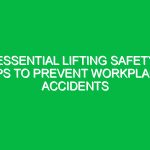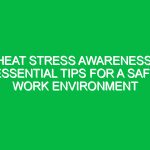Introduction
Living under power lines is a reality for many individuals and families worldwide. These high-voltage transmission lines run through urban and rural areas, often crossing residential neighborhoods. The proximity to power lines raises concerns about health, safety, and environmental impacts, making it a significant topic within the Health, Safety, and Environment (HSE) domain. This article explores the essential insights related to living under power lines, focusing on health risks, safety Precautions, and environmental considerations. By understanding these factors, residents can make informed decisions about their living conditions and advocate for safer environments.
Understanding Power Lines and Their Effects
Power lines carry electricity from generating stations to substations and ultimately to homes and businesses. There are two main types: high-voltage transmission lines and lower-voltage distribution lines. High-voltage lines are typically seen above ground and can span vast distances. They are essential for delivering electricity efficiently, but their presence raises questions about potential health risks.
Health Risks Associated with Living Under Power Lines
One of the primary concerns regarding living under power lines is the exposure to electromagnetic fields (EMFs). EMFs are invisible areas of energy that surround electrical devices, including power lines. While extensive research has been conducted, the results remain mixed, leading to ongoing debate about the long-term health effects of EMF exposure.
Potential Health Concerns
- Cancer Risks: Some studies have suggested a possible link between prolonged exposure to EMFs and an increased risk of certain types of cancer, particularly childhood leukemia. However, the evidence is not conclusive, and many health organizations, including the World Health Organization (WHO), state that current research does not support a direct causal relationship.
- Neurological Effects: Other research has explored potential neurological effects, such as headaches, fatigue, and sleep disturbances. While many individuals report symptoms, establishing a direct link to EMF exposure remains a challenge.
- Electrosensitivity: A small percentage of the population claims to experience electrosensitivity, where they report adverse health effects attributed to EMF exposure. However, scientific validation of this condition is limited.
Safety Considerations for Residents
Beyond health concerns, safety is paramount for those living near power lines. Here are some essential Safety considerations:
1. Physical Hazards
Power lines present physical Hazards, including the risk of electrical shock. Residents should maintain a safe distance from downed lines and report any issues immediately. It’s crucial to educate children about the dangers of climbing trees or playing near power lines.
2. Emergency Preparedness
Living near power lines may increase the risk of power outages during severe weather. Residents should prepare emergency kits and establish communication plans to ensure Safety during storms or other emergencies.
3. Landscaping and Home Maintenance
When landscaping or maintaining property under power lines, residents should avoid planting tall trees or structures that could interfere with the lines. Utility companies often have guidelines on how close vegetation can be to power lines, which should be followed to prevent accidents.
Environmental Considerations
The environmental impact of living under power lines is another critical aspect. The construction and maintenance of power lines can disrupt local ecosystems. Here, we explore various environmental factors to consider:
Impact on Wildlife
Power lines can pose a hazard to birds and other wildlife. Birds may collide with the lines, leading to injury or death. Additionally, the clearing of land for power line installation can destroy habitats. Residents should be aware of local wildlife and advocate for measures that minimize ecological disruption.
Visual and Aesthetic Concerns
Aesthetic concerns also arise when living under power lines. The presence of large towers and cables can impact property values and the overall beauty of the landscape. Communities can work together to address these concerns, advocating for underground power lines or better landscaping to minimize visual impacts.
Regulations and Standards
In the context of health, safety, and environmental concerns, various Regulations govern the placement and maintenance of power lines. These regulations vary by country and region but generally focus on safety standards and environmental protections.
National Electrical Safety Code (NESC)
In the United States, the National Electrical Safety Code sets safety standards for power lines, ensuring they are installed and maintained to minimize risks. These standards include clearance requirements to ensure safety for both people and property.
Environmental Protection Regulations
Many countries have environmental regulations that require assessments before constructing power lines. These assessments evaluate the potential impact on local ecosystems and wildlife. Residents should be aware of these regulations and participate in public hearings to voice their concerns.
Best Practices for Residents Living Under Power Lines
To ensure a safe and healthy living environment under power lines, residents can adopt several Best Practices:
1. Stay Informed
Knowledge is power. Residents should stay informed about the potential health and safety implications of living near power lines. Regularly review reputable sources and guidelines from health organizations.
2. Engage with Utility Companies
Communicating with local utility companies can provide valuable insights into Safety Measures and maintenance schedules. Residents should not hesitate to report concerns or ask questions about their power lines.
3. Community Advocacy
Joining community groups focused on health and safety can amplify voices advocating for better regulations and practices regarding power lines. Community engagement fosters collective action, which can lead to positive changes.
Conclusion
Living under power lines is a complex issue that intertwines health, safety, and environmental considerations. While ongoing research continues to explore the health risks associated with electromagnetic fields, it is essential for residents to prioritize safety and stay informed. By understanding potential hazards, advocating for regulations, and engaging with local communities, individuals living under power lines can take proactive steps towards ensuring a safe and healthy environment. As we continue to navigate the realities of modern living, it is imperative to balance the need for electricity with our collective responsibility for health and environmental Sustainability.


